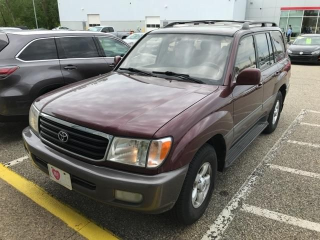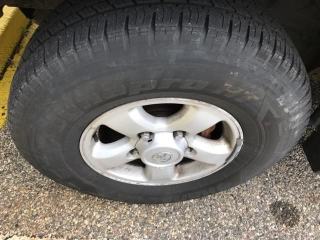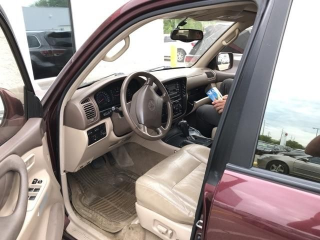The 1998 Toyota Land Cruiser, part of the J80 generation (1990-1997) and the early part of the J100 generation (1998-2007), is a legendary full-size SUV renowned for its unwavering off-road prowess and legendary reliability. Available as a four-door wagon, it offered trims like the base and the more luxurious Amazon (in some markets). Its popularity stems from its robust construction, go-anywhere capability, and Toyota's reputation for durability, making it a sought-after vehicle for adventurers and families alike.
The Good
The 1998 Land Cruiser excels in rugged performance, unmatched reliability, and surprising comfort for its class. Its timeless, rugged design appeals to a sense of adventure, while its enduring value and robust engineering offer peace of mind and practicality for years of dependable service.
The Bad
Common concerns for the 1998 Land Cruiser include potential rust issues, particularly on the frame and body, aging suspension components, and minor electrical gremlins. Older models may also exhibit wear on interior materials and a thirst for fuel compared to modern SUVs.
1998 Toyota Land Cruiser: Quick Overview
- Engine Options: The primary engine for the 1998 model year in North America was the 4.7L 2UZ-FE V8 engine. In other markets, the 4.5L 1FZ-FE inline-6 gasoline engine and various diesel engines might have been available.
- Horsepower: The 4.7L V8 typically produced around 230 horsepower. The 4.5L inline-6 produced approximately 212 horsepower.
- Fuel Economy: Fuel economy is not a strong suit. Expect figures in the range of 12-14 MPG city and 15-17 MPG highway for the V8.
- 0-60 Times: Around 9-10 seconds for the V8, depending on conditions and load.
- Towing Capacity: Generally rated around 5,000 lbs, though this can vary slightly by specific configuration and year.
- Transmission: Primarily offered with a 4-speed automatic transmission.
- Drivetrain: Full-time 4WD with a locking center differential.
- Trim-Level Features (Common):
Standard: Power windows, power door locks, air conditioning, cruise control, tilt steering wheel, AM/FM/CD stereo, anti-lock braking system (ABS), driver and front passenger airbags.
Optional/Higher Trims: Leather upholstery, heated front seats, power adjustable front seats, sunroof, premium audio system, automatic climate control, rear differential lock (on some models), side-view mirror turn signals, fog lights. - Suspension: Front independent suspension, solid rear axle with coil springs (often a triple-link coil spring setup).
- Wheels: Typically 16-inch alloy wheels.
1998 Toyota Land Cruiser Specifications
Vehicle Information
| Year | 1998 |
| Make | Toyota |
| Model | Land Cruiser |
| Trim | - |
| Style | 4WD |
| Type | Sport Utility Vehicle |
| Category | Standard Sport Utility Vehicle |
Manufacturing Details
| Made In | Japan |
| Manufacturing City | TOYOTA CITY |
Dimensions
| Doors | 4-Door |
| Curb Weight | 5225 pounds |
| Gross Vehicle Weight Rating | 6860 pounds |
| Overall Height | 73.20 inches |
| Overall Length | 192.50 inches |
| Overall Width | 76.40 inches |
| Wheelbase Length | 112.20 inches |
| Standard Seating | 5 |
Engine & Performance
| Engine | 4.7-L V-8 SOHC 16V |
| Engine Size | 4.7L |
| Engine Cylinders | 8 |
| Transmission | 4-Speed Automatic |
| Transmission Type | Automatic |
| Transmission Speeds | 4-Speed |
| Drivetrain | Four-Wheel Drive |
Additional Features
| Anti-Brake System | 4-Wheel ABS |
| Steering Type | Rack & Pinion |
Pricing
| Manufacturer Suggested Retail Price (MSRP) | $45,950 |
| Invoice Price | $39,518 |
| Delivery Charges | - |
Vehicle History Report
Vehicle
Specifications
Specifications
Ownership
History
History
All History
Events
Events
NMVTIS Title
History Check
History Check
Salvage/Rebuilt
Check
Check
Accident
Check
Check
Theft
Check
Check
Open Lien
Check
Check
Past Sale
Listings
Listings
Safety
Recalls
Recalls
Odometer
Check
Check
Market Price
Analysis
Analysis
What Problems Does the 1998 Toyota Land Cruiser Have?
The 1998 Toyota Land Cruiser, despite its stellar reputation, isn't entirely immune to issues. One of the most significant long-term concerns is potential frame rust. This is especially prevalent in areas where salt is used on roads during winter. Inspecting the frame thoroughly for corrosion, particularly around suspension mounting points and fuel tank areas, is crucial. Body rust, especially on the rocker panels and rear quarter panels, can also be an issue.
The 4.7L 2UZ-FE V8 engine, while generally robust, can suffer from a rear main seal leak, which is an expensive repair due to the labor involved. The timing belt needs regular replacement (typically every 90,000 miles or so), and neglecting this can lead to catastrophic engine damage. Cooling system components, such as the radiator and water pump, can age and fail over time, so regular inspection and maintenance are advised.
Regarding transmission, the 4-speed automatic is generally reliable, but like any older automatic, fluid changes are essential to prolong its life. Some owners have reported occasional transmission shifting issues or premature wear if not properly maintained.
Electrical gremlins, though not widespread, can occur in older vehicles. This might include issues with power windows, door locks, or the climate control system. Sensors can also fail with age. Suspension components, such as bushings, ball joints, and shock absorbers, will naturally wear out over time, leading to a less comfortable ride and potential handling issues if not replaced.
While specific model year recalls for major issues on the 1998 model aren't extensive, it's always wise to check the NHTSA website for any applicable recalls or Technical Service Bulletins (TSBs) for this specific vehicle. Overall, the 1998 Land Cruiser is known for its long-term reliability, but proactive maintenance and thorough inspections for common wear items are key.
The 4.7L 2UZ-FE V8 engine, while generally robust, can suffer from a rear main seal leak, which is an expensive repair due to the labor involved. The timing belt needs regular replacement (typically every 90,000 miles or so), and neglecting this can lead to catastrophic engine damage. Cooling system components, such as the radiator and water pump, can age and fail over time, so regular inspection and maintenance are advised.
Regarding transmission, the 4-speed automatic is generally reliable, but like any older automatic, fluid changes are essential to prolong its life. Some owners have reported occasional transmission shifting issues or premature wear if not properly maintained.
Electrical gremlins, though not widespread, can occur in older vehicles. This might include issues with power windows, door locks, or the climate control system. Sensors can also fail with age. Suspension components, such as bushings, ball joints, and shock absorbers, will naturally wear out over time, leading to a less comfortable ride and potential handling issues if not replaced.
While specific model year recalls for major issues on the 1998 model aren't extensive, it's always wise to check the NHTSA website for any applicable recalls or Technical Service Bulletins (TSBs) for this specific vehicle. Overall, the 1998 Land Cruiser is known for its long-term reliability, but proactive maintenance and thorough inspections for common wear items are key.
How long will the 1998 Toyota Land Cruiser last?
With proper and consistent maintenance, the 1998 Toyota Land Cruiser is renowned for its exceptional long-term durability, routinely exceeding 200,000 miles and often reaching well over 300,000 miles. Many owners report their Land Cruisers lasting for 15-20 years or more in service. The key to this longevity lies in regular fluid changes (engine oil, transmission fluid, coolant, differential fluid), timely replacement of wear items like brakes and timing belts, and addressing minor issues before they escalate. Weaknesses that can impact lifespan if neglected include frame rust, which can compromise structural integrity, and cooling system failures, which can lead to severe engine damage.
What Technology & Safety Features are Included?
The 1998 Toyota Land Cruiser represents the technological peak of its era, focusing on robust functionality rather than cutting-edge digital interfaces. Standard safety features included anti-lock braking system (ABS) for improved stopping control, and driver and front passenger airbags for frontal impact protection.
In terms of technology and entertainment, the base models typically came equipped with a fairly standard AM/FM stereo system with a CD player. Higher trim levels, or optional packages, often upgraded this to a premium audio system, sometimes with more speakers and enhanced sound quality. Features like power windows, power door locks, and cruise control were standard, contributing to driver convenience. An automatic climate control system was often an option, offering more precise temperature management than manual A/C.
Driver-assistance features were very limited by today's standards. There were no advanced electronic stability or traction control systems commonly found in modern vehicles. The full-time four-wheel-drive system with its locking center differential was the primary mechanical aid for maintaining traction in challenging conditions.
Crash-test ratings for this era are not directly comparable to current NHTSA or IIHS standards, as testing methodologies have evolved significantly. However, the Land Cruiser's body-on-frame construction and substantial curb weight generally offered good occupant protection for its time. The reinforced chassis and safety cage were designed to withstand impacts. Despite the lack of modern electronic aids, its mechanical systems were robust, and its sheer size provided a notable sense of security. Optional features might have included a rear differential lock on some expedition-oriented trims, further enhancing its off-road capability.
In terms of technology and entertainment, the base models typically came equipped with a fairly standard AM/FM stereo system with a CD player. Higher trim levels, or optional packages, often upgraded this to a premium audio system, sometimes with more speakers and enhanced sound quality. Features like power windows, power door locks, and cruise control were standard, contributing to driver convenience. An automatic climate control system was often an option, offering more precise temperature management than manual A/C.
Driver-assistance features were very limited by today's standards. There were no advanced electronic stability or traction control systems commonly found in modern vehicles. The full-time four-wheel-drive system with its locking center differential was the primary mechanical aid for maintaining traction in challenging conditions.
Crash-test ratings for this era are not directly comparable to current NHTSA or IIHS standards, as testing methodologies have evolved significantly. However, the Land Cruiser's body-on-frame construction and substantial curb weight generally offered good occupant protection for its time. The reinforced chassis and safety cage were designed to withstand impacts. Despite the lack of modern electronic aids, its mechanical systems were robust, and its sheer size provided a notable sense of security. Optional features might have included a rear differential lock on some expedition-oriented trims, further enhancing its off-road capability.
What Colors Options are Available?
1998 Toyota Land Cruiser Prices and Market Value
When new, the 1998 Toyota Land Cruiser commanded a premium price, typically ranging from around $45,000 to $55,000, depending on trim and options. Despite its age, the Land Cruiser holds its value exceptionally well, a testament to its legendary reliability and off-road capability. Depreciation is relatively slow compared to other SUVs of its vintage. Factors significantly affecting its current used market price (ranging from $5,000 to $15,000+ for well-maintained examples) include mileage, overall condition, maintenance history, rust presence, and the specific trim level. Enthusiast demand and its reputation as a reliable adventure vehicle contribute to its strong resale value, especially for lower-mileage, rust-free examples.
1998 Toyota Land Cruiser Cost of Ownership
Owning a 1998 Toyota Land Cruiser can be costly, especially in terms of fuel economy; expect to spend significantly on gasoline due to its V8 engine and substantial weight. Insurance costs can be moderate to high, depending on your record and location. Maintenance, while often straightforward due to its robust design, can become expensive if major components need replacement, such as the timing belt or if rust repairs are necessary. Repair costs for specialized parts or labor can also be higher. Overall, it is not an economical vehicle to own, but its longevity and capability can justify the expense for many owners.
1998 Toyota Land Cruiser Fuel Efficiency
Fuel Type
Gasoline
Fuel Capacity
25.40 gallons
City Mileage
14 miles/gallon
Highway Mileage
16 miles/gallon
1998 Toyota Land Cruiser Safety Rating
NHTSA
IIHS
1998 Toyota Land Cruiser Warranty
Basic
Original warranty
36 months / 36,000 miles
Estimated remaining
Expired
Powertrain
Original warranty
60 months / 60,000 miles
Estimated remaining
Expired
Rust
Original warranty
60 months / unlimited miles
Estimated remaining
Expired
1998 Toyota Land Cruiser Insurance
Insurance for a 1998 Toyota Land Cruiser is moderately priced, reflecting its status as a Sport Utility Vehicle with strong safety ratings and
reasonable repair costs.
reasonable repair costs.
How Does the 1998 Toyota Land Cruiser Compare to Other Sport Utility Vehicle?
The 1998 Toyota Land Cruiser competed in a segment of capable, large SUVs. Key rivals included the Ford Expedition, Chevrolet Tahoe/Suburban, and Jeep Grand Cherokee.
Performance: The Land Cruiser's 4.7L V8 offered respectable power, but rivals like the Expedition with its larger V8s often had a slight edge in raw horsepower. However, the Land Cruiser's full-time 4WD system and locking center differential gave it superior off-road performance compared to most American counterparts, which often featured part-time 4WD or were less focused on extreme terrain.
Features: In 1998, the Land Cruiser offered a good array of luxury and convenience features for its time, comparable to or exceeding many rivals, especially in higher trims. Leather, premium audio, and automatic climate control were available. However, American rivals might have offered more advanced infotainment options or a wider range of electronic creature comforts.
Reliability: This is where the Land Cruiser truly shines. While American SUVs from this era could be prone to electrical issues, transmission problems, and general wear and tear, the Land Cruiser is legendary for its bulletproof mechanicals and long-term durability. Ford and Chevy SUVs were generally less reliable over the long haul.
Price: The Land Cruiser was consistently one of the most expensive SUVs when new, significantly pricier than its domestic competitors. This premium also carries over to the used market, where well-maintained examples command higher prices due to their reputation.
Alternatives:
Similar: The Lexus LX 470 (sharing much of its platform and drivetrain with the Land Cruiser) offers a more luxurious experience and is an excellent alternative if budget allows. The Nissan Pathfinder (later generations) could offer decent off-road capability but generally not the same level of refinement or outright durability.
Better (for specific needs): If pure off-road capability is the priority and luxury is secondary, a Jeep Wrangler or older Land Rover Defender would be considered, though reliability on the latter can be a concern. If on-road comfort and a more car-like driving experience are preferred, a Lincoln Navigator or Cadillac Escalade might be considered, though they lack the Land Cruiser's off-road prowess and extreme reliability reputation.
Performance: The Land Cruiser's 4.7L V8 offered respectable power, but rivals like the Expedition with its larger V8s often had a slight edge in raw horsepower. However, the Land Cruiser's full-time 4WD system and locking center differential gave it superior off-road performance compared to most American counterparts, which often featured part-time 4WD or were less focused on extreme terrain.
Features: In 1998, the Land Cruiser offered a good array of luxury and convenience features for its time, comparable to or exceeding many rivals, especially in higher trims. Leather, premium audio, and automatic climate control were available. However, American rivals might have offered more advanced infotainment options or a wider range of electronic creature comforts.
Reliability: This is where the Land Cruiser truly shines. While American SUVs from this era could be prone to electrical issues, transmission problems, and general wear and tear, the Land Cruiser is legendary for its bulletproof mechanicals and long-term durability. Ford and Chevy SUVs were generally less reliable over the long haul.
Price: The Land Cruiser was consistently one of the most expensive SUVs when new, significantly pricier than its domestic competitors. This premium also carries over to the used market, where well-maintained examples command higher prices due to their reputation.
Alternatives:
Similar: The Lexus LX 470 (sharing much of its platform and drivetrain with the Land Cruiser) offers a more luxurious experience and is an excellent alternative if budget allows. The Nissan Pathfinder (later generations) could offer decent off-road capability but generally not the same level of refinement or outright durability.
Better (for specific needs): If pure off-road capability is the priority and luxury is secondary, a Jeep Wrangler or older Land Rover Defender would be considered, though reliability on the latter can be a concern. If on-road comfort and a more car-like driving experience are preferred, a Lincoln Navigator or Cadillac Escalade might be considered, though they lack the Land Cruiser's off-road prowess and extreme reliability reputation.
Final Verdict: Is the 1998 Toyota Land Cruiser a Good Sport Utility Vehicle?
The 1998 Toyota Land Cruiser is ideal for individuals or families seeking an exceptionally reliable, go-anywhere SUV with a proven track record of durability. It's perfect for adventurers, off-road enthusiasts, or those who need a robust vehicle for demanding conditions. It is absolutely worth buying if you prioritize long-term ownership, reliability over luxury amenities, and are willing to perform diligent maintenance. Buying used is the only practical option. Look for examples with comprehensive maintenance records, minimal rust (especially on the frame), and lower mileage. Higher trims often offer more comfort, but the core mechanicals remain the same. This vehicle is a solid investment for the right buyer who understands its strengths and potential maintenance needs.



